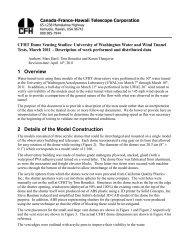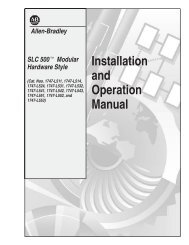Documentation [PDF] - Canada France Hawaii Telescope ...
Documentation [PDF] - Canada France Hawaii Telescope ...
Documentation [PDF] - Canada France Hawaii Telescope ...
Create successful ePaper yourself
Turn your PDF publications into a flip-book with our unique Google optimized e-Paper software.
Figure 14: Photometric calibration process of the CFHTLS-Deep stacks and Deep calibration images used for<br />
L99.<br />
MU_MAX (magnitude of the brightest pixel) against MAG diagram (left plot). The saturation level is identified<br />
in the MU_MAX axis from the broadening of the distribution along the MAG direction. The resulting<br />
saturation level is also plotted in the FLUX_RADIUS versus MAG scatter plot. This estimator is quite robust<br />
but can still fail for 1% of the fields for several reasons (such as heterogeneous seeing due to the stacking<br />
of images with different image quality or higher number of objects close to the saturation level which<br />
blur the determination of the saturation limit). For this reason all plots are manually inspected. Finally,<br />
to ensure the cleanest possible calibration sample, an additional 0.5 magnitude margin is subtracted from<br />
the MU_MAX magnitude saturation limit.<br />
Sources in the Deep stacks are matched with the SNLS standards using a nearest neighbor procedure<br />
with a 2 ′′ matching radius. All stars with a non-zero SExtractor flag are discarded (to avoid blended<br />
objects with potentially corrupted photometry). Figure 16 shows the magnitude difference distribution<br />
as a function of reference magnitude after matching. The scatter is low, around 1% in average. The 2-σ<br />
clipping applied only removes a small fraction of objects (as can be seen in the in the right panel).<br />
The final estimator is the median offset after an iterative two-pass 2σ clipping. A linear regression<br />
is used to verify that the estimator does not depend strongly on the magnitude of the selected objects<br />
(which would be a sign of systematic biases in our magnitude measurement scheme).<br />
The list of rescaling factors applied to the stacks are given in the Appendix in Table 33. Images are<br />
rescaled to keep a final zero-point of Vega 30.0. In a last step, these pixels are scaled to a zero-point of<br />
30.0 in AB. Given a magnitude offset of δ SNLS versus the published total magnitude (CAT_SNLS), we get:<br />
δ SNLS = Median_Clipped(MAG_IQ20 i − CAT_SNLS i ) (4)<br />
And we can compute a pixel scaling factor of F SNLS as follows:<br />
20


![Documentation [PDF] - Canada France Hawaii Telescope ...](https://img.yumpu.com/26965302/32/500x640/documentation-pdf-canada-france-hawaii-telescope-.jpg)









